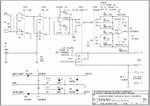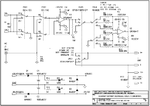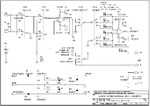David_
Advanced Member level 2
Hello.
I've found this for me very interesting circuit in a paper on Reaserchgate that shows the schematic for a 2mA - 2A AC/DC constant current source made with two OPA544 high-power op-amps, the first is just a unity-gain buffer to supply the required input current to the second which is part of a Howland Current Source, I will post the schematic once I have drawn it in Eagle CAD.
The circuit is incomplete and only feature the actual output stage of what is a system so I have to implement the part of the circuit generating the voltages that should drive the current source which I will do with a microcontroller and a DAC of some kind.
I am in the process of finding out if OPA544 is the best choice since I believe that paper and circuit was made some time ago and there are possibly better choices of op-amp featuring higher GBW(Gain BandWidth product), higher slew-rate, lower offset voltage and so on(if there are other things that might have improved) but even if other power op-amps have become available I will have to deal with between 1mV and 5mV of offset voltage. The only other option I have found from TI at least is the OPA541, there are others such as the OPA2541 but the packages that I can find that in makes it an impossibly expensive part.
The OPA541 features 1mV offset while the OPA544 features 5mV offset, and I find my self hitting a wall thinking about how do I deal with that.
Will that not create a large error in the end in my output setting for the constant current?'
Can I account for it to eliminate it with software?
Can I compensate for it somehow?
Since this is a hobby project sort of thing manual trimming with potentiometers are an acceptable solution even i it isn't the best one, for some reason don't like the idea of trim-pots with a little bit of glue on them to hold them into place, but it worked for the industry before so why not.
But is it really as easy as introducing my own adjustable countering "offset voltage" to one of the op-amp inputs?
Then maybe I could use a high-resolution DAC to make it all done in software, I haven't really gotten to grips with the Howland Current Source and how it actually works but I hope that there are some suitable way of hooking in an ADC to digitize the output current information without adding another current sensing resistor.
Because in order to successfully make the offset adjustment from software I need feedback from an ADC showing the results.
Regards.
I've found this for me very interesting circuit in a paper on Reaserchgate that shows the schematic for a 2mA - 2A AC/DC constant current source made with two OPA544 high-power op-amps, the first is just a unity-gain buffer to supply the required input current to the second which is part of a Howland Current Source, I will post the schematic once I have drawn it in Eagle CAD.
The circuit is incomplete and only feature the actual output stage of what is a system so I have to implement the part of the circuit generating the voltages that should drive the current source which I will do with a microcontroller and a DAC of some kind.
I am in the process of finding out if OPA544 is the best choice since I believe that paper and circuit was made some time ago and there are possibly better choices of op-amp featuring higher GBW(Gain BandWidth product), higher slew-rate, lower offset voltage and so on(if there are other things that might have improved) but even if other power op-amps have become available I will have to deal with between 1mV and 5mV of offset voltage. The only other option I have found from TI at least is the OPA541, there are others such as the OPA2541 but the packages that I can find that in makes it an impossibly expensive part.
The OPA541 features 1mV offset while the OPA544 features 5mV offset, and I find my self hitting a wall thinking about how do I deal with that.
Will that not create a large error in the end in my output setting for the constant current?'
Can I account for it to eliminate it with software?
Can I compensate for it somehow?
Since this is a hobby project sort of thing manual trimming with potentiometers are an acceptable solution even i it isn't the best one, for some reason don't like the idea of trim-pots with a little bit of glue on them to hold them into place, but it worked for the industry before so why not.
But is it really as easy as introducing my own adjustable countering "offset voltage" to one of the op-amp inputs?
Then maybe I could use a high-resolution DAC to make it all done in software, I haven't really gotten to grips with the Howland Current Source and how it actually works but I hope that there are some suitable way of hooking in an ADC to digitize the output current information without adding another current sensing resistor.
Because in order to successfully make the offset adjustment from software I need feedback from an ADC showing the results.
Regards.


